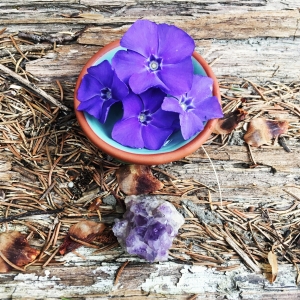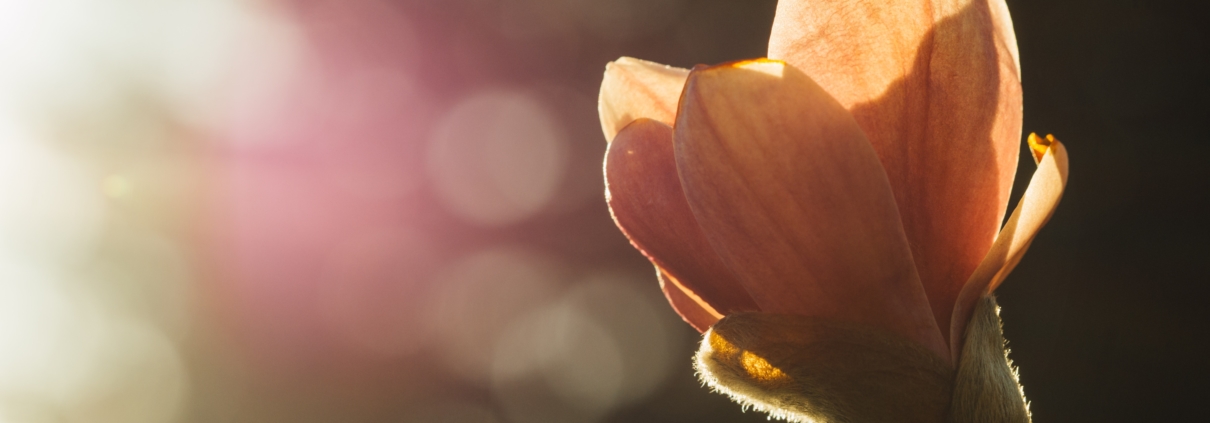Stepping Into The Light: Honouring Beltane
Beltane is the name given to the pre-Christian Celtic fire festival that marked the entry into the summer season celebrated the fertility of the bright half of the year. The word itself likely comes from Old Irish roots and is said to mean “bright fire”, which is a beautifully evocative name for this cross-quarter fire festival. The Celtic wheel of the year is marked off by four quarter-day festivals, and four cross-quarter festivals. The quarter-day festivals are those of the solstices and equinoxes, which signify the entry into the primary seasons of winter, spring, summer and fall, while the cross-quarter  festivals fall about halfway between each of these quarter days. The four cross-quarter feasts are Imbolc (Feb 2nd) Beltane (May 1st), Lammas (Aug), and Samhain (Nov 1). The cross-quarter days are fire festivals and were historically celebrated on the eve of the feast day itself. For instance the Beltane, or May Day, fires would be lit on the last day of April, and the festivities would last until the night of May 1st.
festivals fall about halfway between each of these quarter days. The four cross-quarter feasts are Imbolc (Feb 2nd) Beltane (May 1st), Lammas (Aug), and Samhain (Nov 1). The cross-quarter days are fire festivals and were historically celebrated on the eve of the feast day itself. For instance the Beltane, or May Day, fires would be lit on the last day of April, and the festivities would last until the night of May 1st.
All early agricultural societies kept feast days that marked the passage of the seasons. These feast days provided opportunities for the community to participate in rituals that offered thanks for the blessings of the earth, the support of the land spirits, and the guidance of the ancestors. Rituals of this type supported people in connecting the rhythms of their own lives to the larger rhythms of nature. While many of us in the modern world do not celebrate in the same way our early ancestors did, I do think we feel the symbolic value of seasonal holidays as a way of marking sacred time in our own lives, whether we celebrate them as religious holidays or not.
There is much that is unknown about how Beltane was traditionally celebrated as the early cultures that celebrated the feast day were primarily oral, meaning they did not leave written records. The rites of these people were also folded into Christian celebrations over time so it can be difficult to say with certainty what the pre-Christian rituals looked like. But local folklore, regional mythology, and archaeological remains do offer us some clues, as does a close look at modern May Day celebrations. Some common themes that emerge are the symbolic use of fire, the celebration of fertility, and offerings of both propitiation and gratitude to beings of the otherworld (land spirits, sidhe, fairy folk, ghosts etc).
What does Beltane mean to me?
I was a witch long before I was a yogin. Meaning my interest in spirituality has long been rooted in a fascination with earth-based traditions. Like many young girls who grew up in the eighties, I read Marion Zimmer Bradley’s Mists of Avalon and was enchanted by the idea of the fictional Druids and priestesses of Avalon depicted in those pages. By my early teens, I was devouring every book on earth magic I could get my hands on. The nature-based rituals and teachings made sense to me. They also felt very familiar.
In my late teens and early twenties, I spent a couple of years living unplugged and off the grid. This was an experience that gave me a visceral connection to natural rhythms (both solar and lunar), a connection that has never left me. Because of all this, I have honored the eight Celtic sabbats in some way for a very long time, even if it was simply to take some time to sit with my open journal and a lit candle to reflect on what has passed since the last turn of the wheel.
I consider myself a hedge witch or solitary practitioner, and though I participated in a number of group rituals in my younger years they often felt too contrived for me, and so I preferred to find my own way. However, I will say that one of the most pivotal transformational periods of my life was initiated by a vow I made while jumping over the Beltane fire in the company of a spirited group of witches and wild women in Tofino many long years ago, so I also know firsthand how powerful group rituals can be. In general, I prefer my group rituals to feel organic, with a healthy dose of both reverence and mirth. Personally, I tend to shy away from anything that feels overtly religious or hierarchical. If you too are more called to solitary celebrations I will share with you a number of practices you can do on your own later in this article.
I am now 42 years old and as my relationship to myself, my ancestry, and this earth, come into greater states of maturity, each of these seasonal feasts continue to reveal more and more hidden meaning.
Lighting the Beltane fire
“ On the eve of Beltane, all the fires in the community were extinguished, so that the element of fire was then completely absent from Earth. The Celts reckoned their days from sunset, not from sunrise, for, to their way of thinking, the night was the primeval source of light, and it was from this standpoint that they also perceived their own spiritual identity and consciousness. So when they gathered on their sacred Beltane hill at sunrise to ritually rekindle the need-fire, they were also regenerating their own spiritual vitality. Their bonfire consisted of nine sacred woods from which they relit their hearth fires and then drove their cattle through the smoke in the rite of saining, or purification with fire. Fire was seen as a divine power, and the people also jumped over the bonfire as an act of personal purification and transformation of the spirit.” ~ Helena Patterson, The Celtic Lunar Zodiac
Astrologically the spring season is governed by the fire element as the cardinal fire sign of Aries ushers it in. Fire offers us the bright spark of creativity, the will and the agency to evolve on our spiritual path, and the desire to participate in the ritual of renewal once again. When the sun enters earthy Taurus each year (April 21-May 21) we are more able to draw the brilliance of fire energy down into our material reality. As the earth around us blossoms into life once again, so do we. I believe this is part of what was felt, and celebrated, at the feast of Beltane. Beltane marks the entry into the bright half of the year, a time in which our energy and attention are drawn into the outer world- as it should be. A time in which we are invited to revel in our embodiment and take part in bringing forth life in any way that is natural to us.
In your life this may look like tending a garden, nourishing a burgeoning relationship, caring for your family, or bringing a creative vision into reality. All of these activities are empowered in this season. For myself, Beltane marks a crossing over into a season in which I am drawn deeper into my relationship with the natural world around me. I primarily practice this through wildcrafting, medicine making, and communing with the plant allies in my area. It is a time when my spiritual practices tend to move outdoors, and I find clarity and insight on long walks with my dogs, rather than alone on my yoga mat. This is the season of fertility, growth, and celebration, and as such, I like to adjust my personal sadhana to reflect those themes.
Beltane as portal
Beltane is sometimes referred to as “the time of no time”, and like Samhain (Halloween) is considered a time when the veils between the worlds are thin. This sense of medial space is something I have always felt very clearly at Samhain. That time of year when the days grow dark and the leaves begin to fall has always felt like a time of mystery to me. Beltane though felt very different than that. I have always felt Beltane to be a time of earth magic and empowered sensuality, but I had never directly made the connection to the otherworld aspect of Beltane until recently.
As I’ve already mentioned, the dark season initiated by the feast of Samhain has always felt like a portal for me, an entry into the inner world, a time of heightened intuition and inner knowing. It is in the dark season of the year that I often receive my deepest and most profound insights. It is a time when I gain access to the shadow spaces within my psyche and plant my most powerful seeds of intention. In the last few years, I have been doing more focused work with both deity and ancestral practices and this work has been supported by spirit guides. I think of these guides as my seasonal guests, for they arrive at my table in late autumn and offer me wisdom through my dreams and subtle practices all throughout the dark days and nights of winter. Each year my relationship with my guides deepens, and I very much look forward to crossing the threshold into the dark season at the end of October.
What does this have to do with Beltane? What I now understand is that Beltane is the portal on the other side of the dark season.  The one we pass through when we leave that season behind us and step forward into the season of light. Beltane is a time in which to give our thanks to the spirit guides and ancestors who walked through the dark with us. They have offered us their wisdom and now we must bring it into action in the outer world. Beltane is also a time in which to give offerings to the spirits of the land as it wakes up around us. Traditionally, this was done by leaving milk and offerings of food for the fairy folk. I have been witnessing the tree spirits, green plant allies, and flower folk come to life over the past month and they are calling me to a new kind of attention, one that draws me into a greater relationship with the physical world of which I am a part. Beltane is a time in which I more formally ask for their blessing, in honor of the wisdom they have to share with me.
The one we pass through when we leave that season behind us and step forward into the season of light. Beltane is a time in which to give our thanks to the spirit guides and ancestors who walked through the dark with us. They have offered us their wisdom and now we must bring it into action in the outer world. Beltane is also a time in which to give offerings to the spirits of the land as it wakes up around us. Traditionally, this was done by leaving milk and offerings of food for the fairy folk. I have been witnessing the tree spirits, green plant allies, and flower folk come to life over the past month and they are calling me to a new kind of attention, one that draws me into a greater relationship with the physical world of which I am a part. Beltane is a time in which I more formally ask for their blessing, in honor of the wisdom they have to share with me.
Our ancient ancestors existed within an animist universe. They knew the world was alive with soul. Due to cultural conditioning and a separation from nature, many of us have forgotten this. But it can be re-awakened.
I do not believe the ability to commune with the unseen is a special power. I believe we all have this ability to receive wisdom from the subtle realms. Unfortunately, the outer world speaks so loudly it is hard to hear anything else most of the time. Practices such as sacred timekeeping, personal ritual, journal work, yoga, meditation, working with plant medicines, and spending time in nature have helped me to reclaim my ability to attune to the magic that infuses my everyday experience. These practices and any others you are drawn to can do the same for you, especially if you undertake them with a desire to increase your awareness and sense of connection. If honoring Beltane feels like something you want to weave into your personal practice then below are some ways you might do so.
Some Beltane Rituals
There are many ways in which to mark the passing of Beltane, and this is just a sampling of some of the rituals that I love to do. Pick one or two that delight you and then add your own. I am a firm believer in self-initiated ritual and organic spirituality. Trust your intuition and let it guide you back into remembrance.
- Light a fire on Beltane eve. Lie in the grass, look at the stars and feel the earth waking up around you.
- Go for a long walk in a green space near your home and pay attention to the plants and trees that call out to you. Learn their names, listen to what they have to tell you, find out what they have to offer you.
- Get out your journal, mark the date, and reflect on what your journey through the last six months (from Samhain to Beltane) has been about.
- Light candles, give yourself a scented oil massage and take a long bath. Celebrate sensual pleasure.
- Surround yourself with flowers. Plant some in the earth or in a container. Bring them into your home. Enjoy their beauty.
- Make love! Dance. Do yoga. Walk barefoot in the grass. Delight in your embodiment.
- Make offerings to the natural world around you.
- Give thanks to your ancestors and the spirit guides who walked through this life with you. Even if you do not sense their presence at this time, they are with you. Honor them.
- Consider a sacred cleansing ritual for your home, your body, your heart. Include your animals! The sacred smoke of sage, sweetgrass, palo santo, cedar, and agarwood are perfect for this. But perhaps there are sacred plants that can be used for smudging in your area? Go wildcrafting with this in mind.
- Do any ritual that helps you step joyfully into the light, ready for another season of growth and experience.








